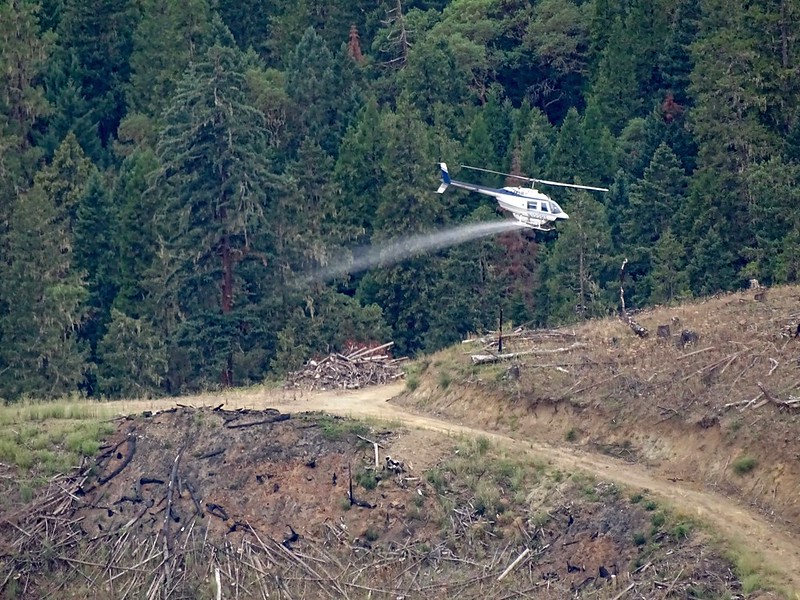
An aerial eradication operation conducted by helicopter.
“The government of Gustavo Petro is taking increasingly decisive steps to achieve the reversal in the drug policy that the president of Colombia proposed on the campaign trail.”
Colombia’s President Gustavo Petro campaigned on a platform of changing the country’s policies toward illicit drugs,[i] and he is making good on that promise. According to Spain’s largest daily, El País, which has excellent coverage of Latin America,the Petro government has announced plans to reduce counterdrug strategic efforts aimed at forced eradication of coca. Previously, these efforts constituted some of the country’s main strategies to curb coca, the raw ingredient in cocaine. Instead, Petro plans to pursue drug traffickers, especially those who do not participate in the ongoing peace negotiations. As an outcome, an end to forced eradication means a far less ambitious effort to reduce the number of hectares under coca cultivation. In the second article, U.S.-funded Spanish language news service Voz de América reports that Colombia now aims to reduce a mere 20,000 hectares under coca cultivation, compared to 50,000 hectares, which was its goal in 2022. Petro’s predecessor, President Ivan Duque, eradicated 130,000 hectares of coca cultivation in 2020. Of note, since assuming office, Petro has also reversed course on fighting guerrilla groups and sought a broad truce with criminal organizations in a plan he calls “Total Peace.”[ii] Bridging the two concerns, the new, less ambitious coca eradication efforts will probably drive instability in Colombia and encourage criminal groups to control more territory to plant coca. Indeed, one outcome of this new counterdrug plan is that it has the potential to undercut Petro’s attempt to bring about “Total Peace” in the country.
Sources:
“El vuelco de Petro en la política de drogas empieza por reducir la erradicación forzada de coca (Petro’s turnaround in drug policy begins by reducing the forced eradication of coca),” El País (Spain’s largest daily with excellent coverage of Latin America), 12 January 2023. https://elpais.com/america-colombia/2023-01-12/el-vuelco-de-petro-en-la-politica-de-drogas-empieza-por-reducir-la-erradicacion-forzada-de-coca.html
The government of Gustavo Petro is taking increasingly decisive steps to achieve the reversal in the drug policy that the president of Colombia proposed on the campaign trail. After having prepared the ground to bury once and for all the aerial spraying with glyphosate against coca crops, this week the National Police set its goal of eradicating illicit crops in 2023 at 20,000 hectares, a notable reduction of 60% with respect to the 50,000 that was proposed for 2022… At the end of 2021, the total area shot up from 143,000 to 204,000 hectares under cultivation, according to the latest annual report of the United Nations Integrated System for Monitoring Illicit Crops (Simci), the official measurement. Cocaine hydrochloride production potential reached 1,400 tons. Both are the highest figures since records were kept.
“Colombia anuncia reducción en su meta de erradicación de cultivos ilícitos (Colombia announces reduction in its goal of eradication of illicit crops),” Voz de América (the Spanish-language version of the state-owned network), 20 January 2023. https://www.vozdeamerica.com/a/colombia-anuncia-reduccion-meta-erradicacion-cultivos-ilicitos-/6927613.html Colombia reduced its goal of eradicating illicit crops to 20,000 hectares in 2023, a total of 30,000 fewer hectares compared to last year’s figure, which was set at 50,000… President Gustavo Petro has described the current anti-drug policy, which has been implemented since by previous governments, as a failure, and recently at the World Economic Forum in Davos, Switzerland, once again assured that this is a failed policy – the main factor in the generation of violence in Colombia.
Notes:
[i] For more background on Petro’s campaign and his policy shift on illicit drugs, see: Ryan Berg, “Colombia’s Gustavo Petro Promises New Approach to Security and Drugs,” OE Watch, 10-2022. https://community.apan.org/wg/tradoc-g2/fmso/m/oe-watch-articles-2-singular-format/428038; Missy Ryan, “In Test of Ties with U.S., Colombian Leader Proposes Shift on Drugs,” Washington Post, 27 September 2022. https://www.washingtonpost.com/national-security/2022/09/27/united-states-colombia-drugs/
[ii] For more information on Petro’s views on guerrilla groups and Colombia’s security challenges more generally, see: Ryan Berg, “Colombia’s Congress Authorizes “Total Peace” Negotiation With Guerrilla and Criminal Groups,” OE Watch, 1-2023. https://community.apan.org/wg/tradoc-g2/fmso/m/oe-watch-articles-2-singular-format/434199; Ryan Berg, “Colombia’s Leftist President Seeks To Resume Negotiations With National Liberation Army,” OE Watch, 9-2022. https://community.apan.org/wg/tradoc-g2/fmso/m/oe-watch-articles-2-singular-format/425694; Christina Noriega, “Colombia’s Radical New Approach to Cocaine,” Foreign Policy, 30 October 2022. https://foreignpolicy.com/2022/10/30/colombia-cocaine-coca-industry-policy-war-drugs-gustavo-petro/
Image Information:
Image: An aerial eradication operation conducted by helicopter.
Source: https://www.flickr.com/photos/umpquawild/28702214956
Attribution: CC BY-NC 2.0
